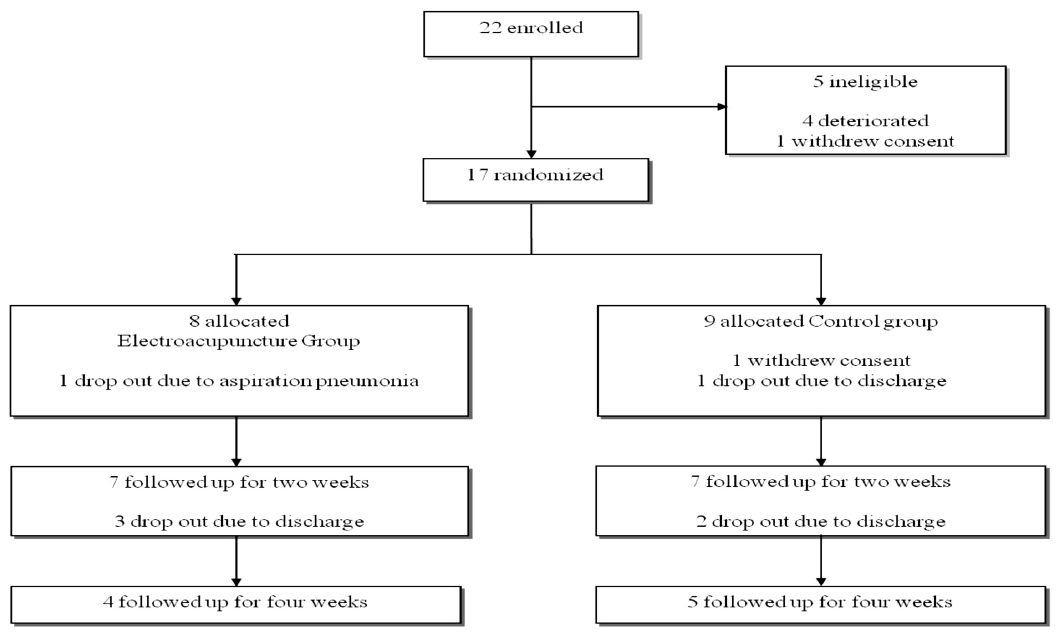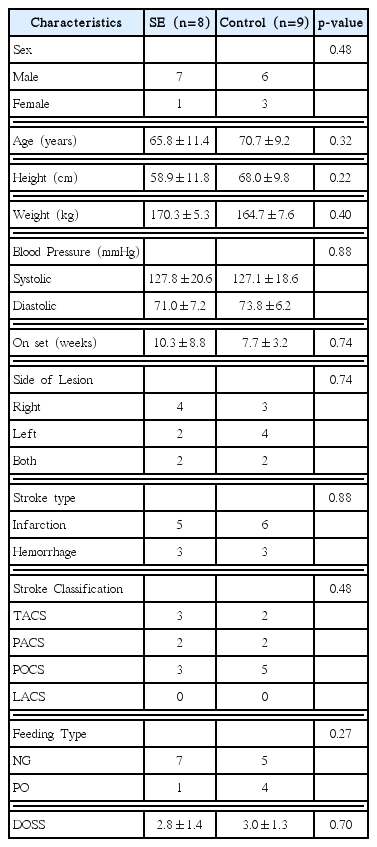References
1. Marik PE, Kaplan D. Aspiration pneumonia and dysphagia in the elderly. Chest 2003;124:328–36.
2. Mann G, Hankey GJ, Cameron D. Swallowing Function After Stroke Prognosis and Prognostic Factors at 6 Months. Stroke 1999;30:744–8.
3. Sharma JC, Fletcher S, Vassallo M, Ross I. What influences outcome of stroke-pyrexia or dysphagia? Int J Clin Pract 2001;55:17–20.
4. Martino R, Foley N, Bhogal S, Diamant N, Speechley M, Teasell R. Dysphagia After Stroke Incidence, Diagnosis, and Pulmonary Complications. Stroke 2005;36:2756–63.
5. Dziewas R, Ritter M, Schilling M, Konrad C, Oelenberg S, Nabavi DG, et al. Pneumonia in acute stroke patients fed by nasogastric tube. J Neurol Neurosurg Psychiatr 2004;75:852–6.
6. Langmore SE, Terpenning MS, Schork A, Chen Y, Murray JT, Lopatin D, et al. Predictors of aspiration pneumonia: how important is dysphagia? Dysphagia 1998;13:69–81.
7. Lim KB, Lee HJ, Lim SS, Choi YI. Neuromuscular electrical and thermal-tactile stimulation for dysphagia caused by stroke: a randomized controlled trial. Journal of Rehabilitation Medicie 2009;41:17–48.
8. Long YB, Wu XP. A meta-analysis of the efficacy of acupuncture in treating dysphagia in patients with a stroke. Acupunct Med 2012;30(4):291–7.
9. Gomez-Busto F, Andia Munoz V, Sarabia M, Ruiz de Alegria L, González de Viñaspre I, López-Molina N, et al. Gelatinous nutritional supplements: a useful alternative in dysphagia. Nutr Hosp 2011;26:775–83.
10. Seki T, Iwasaki K, Arai H, Sasaki H, Hayashi H, Yamada S, et al. Acupuncture for dysphagia in poststroke patients: a videofluoroscopic study. J Am Geriatr Soc 2005;53:108–34.
11. Seki T, Kurusu M, Tanji H, Arai H, Sasaki H. Acupuncture and swallowing reflex in poststroke patients. J Am Geriatr Soc 2003;51:72–67.
12. Kim TH, Na BJ, Rhee JW, Lee CR, Park YM, Choi CM, et al. The Effect of Moxibustion at Chonjung(CV17, Shanzhong) on Patients with Dysphagia after Stroke. 2005;
13. Iwasaki K, Kato S, Monma Y, Niu K, Ohrui T, Okitsu R, et al. A Pilot Study of Banxia Houpu Tang, a Traditional Chinese Medicine, for Reducing Pneumonia Risk in Older Adults with Dementia. Journal of the American Geriatrics Society 2007;55:2035–40.
14. Ertekin C, Aydogdu I, Yüceyar N, Kiylioglu N, Tarlaci S, Uludag B. Pathophysiological mechanisms of oropharyngeal dysphagia in amyotrophic lateral sclerosis. Brain 2000;123:125–40.
15. Kang YW, Na DL, Hahn SH. A validity study on the Korean Mini-Mental State Examination (K-MMSE) in Dementia Patients. J Korean Neurol Assoc 1997;15(2):300–8.
16. O’Neil KH, Purdy M, Falk J, Gallo L. The dysphagia outcome and severity scale. Dysphagia 1999;14:139–45.
17. McHorney CA, Robbins J, Lomax K, Rosenbek JC, Chignell K, Kramer AE, et al. The SWAL-QOL and SWAL-CARE Outcomes Tool for Oropharyngeal Dysphagia in Adults: III. Documentation of Reliability and Validity. Dysphagia 2002;17:97–114.
18. McHorney CA, Bricker DE, Kramer AE, Rosenbek JC, Robbins J, Chignell KA, et al. The SWAL-QOL outcomes tool for oropharyngeal dysphagia in adults: I. Conceptual foundation and item development. Dysphagia 2000;15:115–21.
19. McHorney CA, Bricker DE, Robbins J, Kramer AE, Rosenbek JC, Chignell KA. The SWAL-QOL outcomes tool for oropharyngeal dysphagia in adults: II. Item reduction and preliminary scaling. Dysphagia 2000;15:122–33.
20. Kasner SE. Clinical interpretation and use of stroke scales. The Lancet Neurology 2006;5:603–12.
21. Hocking C1, Williams M, Broad J, Baskett J. Sensitivity of Shah, Vanclay and Cooper’s modified Barthel Index. Clin Rehabil 1999;13(2):141–7.
22. Terre R, Mearin F. Oropharyngeal dysphagia after the acute phase of stroke: predictors of aspiration. Neurogastroenterol Motil 2006;18:200–5.
23. Barer DH. The natural history and functional consequences of dysphagia after hemispheric stroke. J Neurol Neurosurg Psychiatr 1989;52:236–41.
24. Smithard DG, O’Neill PA, England RE, Park CL, Wyatt R, Martin DF, et al. The natural history of dysphagia following a stroke. Dysphagia 1997;12:188–93.
25. Park CL, O’Neill PA, Martin DF. A pilot exploratory study of oral electrical stimulation on swallow function following stroke: an innovative technique. Dysphagia 1997;12:161–6.
26. Carnaby-Mann GDCM. Examining the evidence on neuromuscular electrical stimulation for swallowing: A meta-analysis. 2007;133:564–71.
27. Fraser C, Power M, Hamdy S, Rothwell J, Hobday D, Hollander I, et al. Driving Plasticity in Human Adult Motor Cortex Is Associated with Improved Motor Function after Brain Injury. Neuron 2002;34:831–40.
28. Li KL. Treatment of limb paralysis using low-frequency deep electric stimulation. Med Tr Prom Ekol 1995;(9):33–7.





